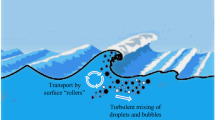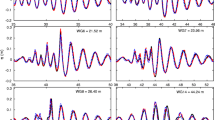Abstract
The dispersion (transport and breakup) of oil droplets under breaking waves is essential for evaluating the impact of oil spills on the environment, and for designing countermeasures. In this part of the work (Part I), the hydrodynamics of a wave breaker in a 1.0 m deep tank obtained experimentally by Rapp and Melville (Philos Trans R Soc Lond A Math Phys Eng Sci 331(1622):735–800, 1990) using the dispersive focusing method was investigated numerically using Reynold-averaged Navier–Stokes (RANS) within the CFD code ANSYS Fluent. The renormalization group (RNG) k–ε turbulence closure model was adopted to simulate wave turbulence, and the transient water–air interface was captured using volume of fluid (VOF) method. The simulated surface excursion and velocity fields matched closely the experimental observations during wave breaking. The energy dissipation of the wave crest showed good agreement with recent laboratory work and numerical simulations through evaluating the breaking parameter. The RANS approach was able to reproduce the turbulent kinetic energy field engendered by the breakers and simulated the residual turbulence within about two wave periods after the passage of the wave train. The VOF scheme Compressive provided a better agreement with the observation than the Geo-reconstruct scheme. The approach herein suggests that RANS method coupled with VOF in ANSYS Fluent is capable of capturing the major hydrodynamic forces and turbulence, and thus could be used to predict environmental processes within the breaking waves such as oil droplet formation and transport.















Similar content being viewed by others
References
Alagan Chella M, Bihs H, Myrhaug D, Muskulus M (2016) Hydrodynamic characteristics and geometric properties of plunging and spilling breakers over impermeable slopes. Ocean Model 103:53–72
ANSYS (2013). ANSYS FLUENT Theory Guide 15.0
Brackbill JU, Kothe DB, Zemach C (1992) A continuum method for modeling surface tension. J Comput Phys 100(2):335–354
Bradford SF (2000) Numerical simulation of surf zone dynamics. J Waterway Port Coast Ocean Eng 126(1):1–13
Brocchini M (2002) Free surface boundary conditions at a bubbly/weakly splashing air–water interface. Phys Fluids 14(6):1834–1840
Brown SA, Greaves DM, Magar V, Conley DC (2016) Evaluation of turbulence closure models under spilling and plunging breakers in the surf zone. Coast Eng 114:177–193
Chang K-A, Liu PL-F (1999) Experimental investigation of turbulence generated by breaking waves in water of intermediate depth. Phys Fluids 11(11):3390–3400
Chen G, Kharif C, Zaleski S, Li J (1999) Two-dimensional Navier–Stokes simulation of breaking waves. Phys Fluids 11(1):121–133
Cui F, Boufadel MC, Geng X, Gao F, Zhao L, King T, Lee K (2018) Oil droplets transport under a deep-water plunging breaker: impact of droplet inertia. J Geophys Res Oceans 123:9082–9100
De Padova D, Ben Meftah M, De Serio F, Mossa M, Sibilla S (2019) Characteristics of breaking vorticity in spilling and plunging waves investigated numerically by SPH. Environ Fluid Mech 20:233–260
Dean RG, Dalrymple RA (1991) Water wave mechanics for engineers and scientists. World Scientific Publishing Co Inc, Singapore
Deane GB, Stokes MD (2002) Scale dependence of bubble creation mechanisms in breaking waves. Nature 418(6900):839–844
Deike L, Melville WK, Popinet S (2016) Air entrainment and bubble statistics in breaking waves. J Fluid Mech 801:91–129
Deike L, Pizzo N, Melville WK (2017) Lagrangian transport by breaking surface waves. J Fluid Mech 829:364–391
Deike L, Popinet S, Melville WK (2015) Capillary effects on wave breaking. J Fluid Mech 769:541–569
Derakhti M, Kirby JT (2014) Bubble entrainment and liquid–bubble interaction under unsteady breaking waves. J Fluid Mech 761:464–506
Derakhti M, Kirby JT (2016) Breaking-onset, energy and momentum flux in unsteady focused wave packets. J Fluid Mech 790:553–581
Derakhti M, Kirby JT, Shi F, Ma G (2016) Wave breaking in the surf zone and deep-water in a non-hydrostatic RANS model. Part 1: organized wave motions. Ocean Model 107:125–138
Devolder B, Rauwoens P, Troch P (2017) Application of a buoyancy-modified k-ω SST turbulence model to simulate wave run-up around a monopile subjected to regular waves using OpenFOAM®. Coast Eng 125:81–94
Devolder B, Troch P, Rauwoens P (2018) Performance of a buoyancy-modified k–ω and k–ω SST turbulence model for simulating wave breaking under regular waves using OpenFOAM®. Coast Eng 138:49–65
Drazen DA, Melville WK (2009) Turbulence and mixing in unsteady breaking surface waves. J Fluid Mech 628:85–119
Drazen DA, Melville WK, Lenain LUC (2008) Inertial scaling of dissipation in unsteady breaking waves. J Fluid Mech 611:307–332
Duncan JH, Longuet-Higgins MS (1981) An experimental investigation of breaking waves produced by a towed hydrofoil. Proc R Soc Lond A Math Phys Sci 377(1770):331–348
Elliott AJ (1986) Shear diffusion and the spread of oil in the surface layers of the North Sea. Dtsch Hydrogr Z 39(3):113–137
Grare L, Peirson WL, Branger H, Walker JW, Giovanangeli J-P, Makin V (2013) Growth and dissipation of wind-forced, deep-water waves. J Fluid Mech 722:5–50
Iafrati A (2009) Numerical study of the effects of the breaking intensity on wave breaking flows. J Fluid Mech 622:371–411
Iafrati A (2011) Energy dissipation mechanisms in wave breaking processes: spilling and highly aerated plunging breaking events. J Geophys Res Oceans 116(C07024)
Iafrati A, Campana EF (2005) Free-surface fluctuations behind microbreakers: space–time behaviour and subsurface flow field. J Fluid Mech 529:311–347
Kamath A, Alagan Chella M, Bihs H, Arntsen ØA (2016) Breaking wave interaction with a vertical cylinder and the effect of breaker location. Ocean Eng 128:105–115
Lakehal D, Liovic P (2011) Turbulence structure and interaction with steep breaking waves. J Fluid Mech 674:522–577
Larsen BE, Fuhrman DR (2018) On the over-production of turbulence beneath surface waves in Reynolds-averaged Navier–Stokes models. J Fluid Mech 853:419–460
Li C, Miller J, Wang J, Koley S, Katz J (2017) Size distribution and dispersion of droplets generated by impingement of breaking waves on oil slicks. J Geophys Res Oceans 122(10):7938–7957
Li Z, Lee K, King T, Boufadel MC, Venosa AD (2009) Evaluating chemical dispersant efficacy in an experimental wave tank: 1—Dispersant effectiveness as function of the energy dissipation rate. Environ Eng Sci 26(6):1139–1148
Lim H-J, Chang K-A, Huang Z-C, Na B (2015) Experimental study on plunging breaking waves in deep water. J Geophys Res Oceans 120(3):2007–2049
Lin M-Y, Moeng C-H, Tsai W-T, Sullivan PP, Belcher SE (2008) Direct numerical simulation of wind-wave generation processes. J Fluid Mech 616:1–30
Longuet-Higgins MS (1988) Mechanisms of wave breaking in deep water. In: Kerman BR (ed) Sea surface sound: natural mechanisms of surface generated noise in the ocean. Springer, Dordrecht, pp 1–30
Longuet-Higgins MS (1998) Vorticity and curvature at a free surface. J Fluid Mech 356:149–153
Longuett-Higgins MS, Cokelet ED (1976) The deformation of steep surface waves on water I. A numerical method of computation. Proc R Soc Lond A 350:1–26
Lubin P, Glockner S (2015) Numerical simulations of three-dimensional plunging breaking waves: generation and evolution of aerated vortex filaments. J Fluid Mech 767:364–393
Lubin P, Vincent S, Abadie S, Caltagirone J-P (2006) Three-dimensional large eddy simulation of air entrainment under plunging breaking waves. Coast Eng 53(8):631–655
Lupieri G, Contento G (2015) Numerical simulations of 2-D steady and unsteady breaking waves. Ocean Eng 106:298–316
Ma G, Shi F, Kirby JT (2011) A polydisperse two-fluid model for surf zone bubble simulation. J Geophys Res Oceans 116(C05010)
Melville WK (1994) Energy dissipation by breaking waves. Oceanograph Lit Rev 24(10):2041–2049
Melville WK, Veron F, White CJ (2002) The velocity field under breaking waves: coherent structures and turbulence. J Fluid Mech 454:203–233
Menter FR (1994) Two-equation eddy-viscosity turbulence models for engineering applications. AIAA J 32(8):1598–1605
Noh WF, Woodward P (1976) SLIC (Simple Line Interface Calculation). In: van de Vooren AI, Zandbergen PJ (eds) Proceedings of the fifth international conference on numerical methods in fluid dynamics 28 June–July 2 1976 Twente University, Enschede. Springer, Berlin, pp 330–340
Perlin M, He J, Bernal LP (1996) An experimental study of deep water plunging breakers. Phys Fluids 8(9):2365–2374
Phillips OM (1985) Spectral and statistical properties of the equilibrium range in wind-generated gravity waves. J Fluid Mech 156:505–531
Pizzo NE, Melville WK (2013) Vortex generation by deep-water breaking waves. J Fluid Mech 734:198–218
Pizzo NE, Melville WK (2016) Wave modulation: the geometry, kinematics, and dynamics of surface-wave packets. J Fluid Mech 803:292–312
Rapp RJ, Melville W (1990) Laboratory measurements of deep-water breaking waves. Philos Trans R Soc Lond A Math Phys Eng Sci 331(1622):735–800
Romero L, Melville WK, Kleiss JM (2012) Spectral energy dissipation due to surface wave breaking. J Phys Oceanogr 42(9):1421–1444
Sullivan PP, McWilliams JC, Melville WK (2007) Surface gravity wave effects in the oceanic boundary layer: large-eddy simulation with vortex force and stochastic breakers. J Fluid Mech 593:405–452
Tanaka M (2001) A method of studying nonlinear random field of surface gravity waves by direct numerical simulation. Fluid Dyn Res 28(1):41–60
Tian Z, Perlin M, Choi W (2010) Energy dissipation in two-dimensional unsteady plunging breakers and an eddy viscosity model. J Fluid Mech 655:217–257
Tian Z, Perlin M, Choi W (2012) An eddy viscosity model for two-dimensional breaking waves and its validation with laboratory experiments. Phys Fluids 24(3):036601
Ting FCK, Kirby JT (1994) Observation of undertow and turbulence in a laboratory surf zone. Coast Eng 24(1):51–80
Ubbink O (1997). Numerical prediction of two fluid systems with sharp interfaces. Doctor of Philosophy, Imperial College of Science, Technology and Medicine
Wilcox DC (2008) Formulation of the k-w turbulence model revisited. AIAA J 46(11):2823–2838
Xie Z (2013) Two-phase flow modelling of spilling and plunging breaking waves. Appl Math Model 37(6):3698–3713
Yakhot V, Orszag S, Thangam S, Gatski T, Speziale C (1992) Development of turbulence models for shear flows by a double expansion technique. Phys Fluids A 4(7):1510–1520
Yakhot V, Orszag SA (1986) Renormalization group analysis of turbulence. I. Basic theory. J Sci Comput 1(1):3–51
Youngs D (1982) Time-dependent multi-material flow with large fluid distortion. Numer Methods Fluid Dyn 24:273–285
Zhao L, Torlapati J, Boufadel MC, King T, Robinson B, Lee K (2014) VDROP: a comprehensive model for droplet formation of oils and gases in liquids-Incorporation of the interfacial tension and droplet viscosity. Chem Eng J 253:93–106
Zhao Q, Tanimoto K (1999) Numerical simulation of breaking waves by large eddy simulation and VOF method. Coast Eng 1998:892–905
Zheyu Z, Tian-Jian H, Daniel C, Xiaofeng L (2017) Large-eddy simulation of wave-breaking induced turbulent coherent structures and suspended sediment transport on a barred beach. J Geophys Res Oceans 122(1):207–235
Zhou Z, Sangermano J, Hsu T-J, Ting FCK (2014) A numerical investigation of wave-breaking-induced turbulent coherent structure under a solitary wave. J Geophys Res Oceans 119(10):6952–6973
Acknowledgements
This research was supported by a contract with the Department of Fisheries and Oceans Canada, Center for Offshore Oil and Gas Exploration Research, and through a grant from the Multi-Partner Research Initiative under Grant Number MECTS-#3939073-v1-OFSCP. However, no official endorsement should be implied by these entities. This work used the Extreme Science and Engineering Discovery Environment (XSEDE), which is supported by National Science Foundation (NSF) Grant Number TG-BCS190002. Specifically, we used the Bridges computer cluster, which is an NSF-funded system at the Pittsburgh Supercomputing Center (PSC).
Author information
Authors and Affiliations
Corresponding author
Additional information
Publisher's Note
Springer Nature remains neutral with regard to jurisdictional claims in published maps and institutional affiliations.
Appendix
Appendix
Time series of the horizontal velocity (left panel) and vertical velocity (right panel) at x = 0.0 m (inlet boundary) and z = 0.6 m (water level in the absence of waves). The vertical velocity is 90o degree out of phase with the horizontal velocity, so, for example, the vertical velocity is zero when the horizontal velocity is maximum
Rights and permissions
About this article
Cite this article
Cui, F., Daskiran, C., King, T. et al. Modeling oil dispersion under breaking waves. Part I: Wave hydrodynamics. Environ Fluid Mech 20, 1527–1551 (2020). https://doi.org/10.1007/s10652-020-09753-7
Received:
Accepted:
Published:
Issue Date:
DOI: https://doi.org/10.1007/s10652-020-09753-7





